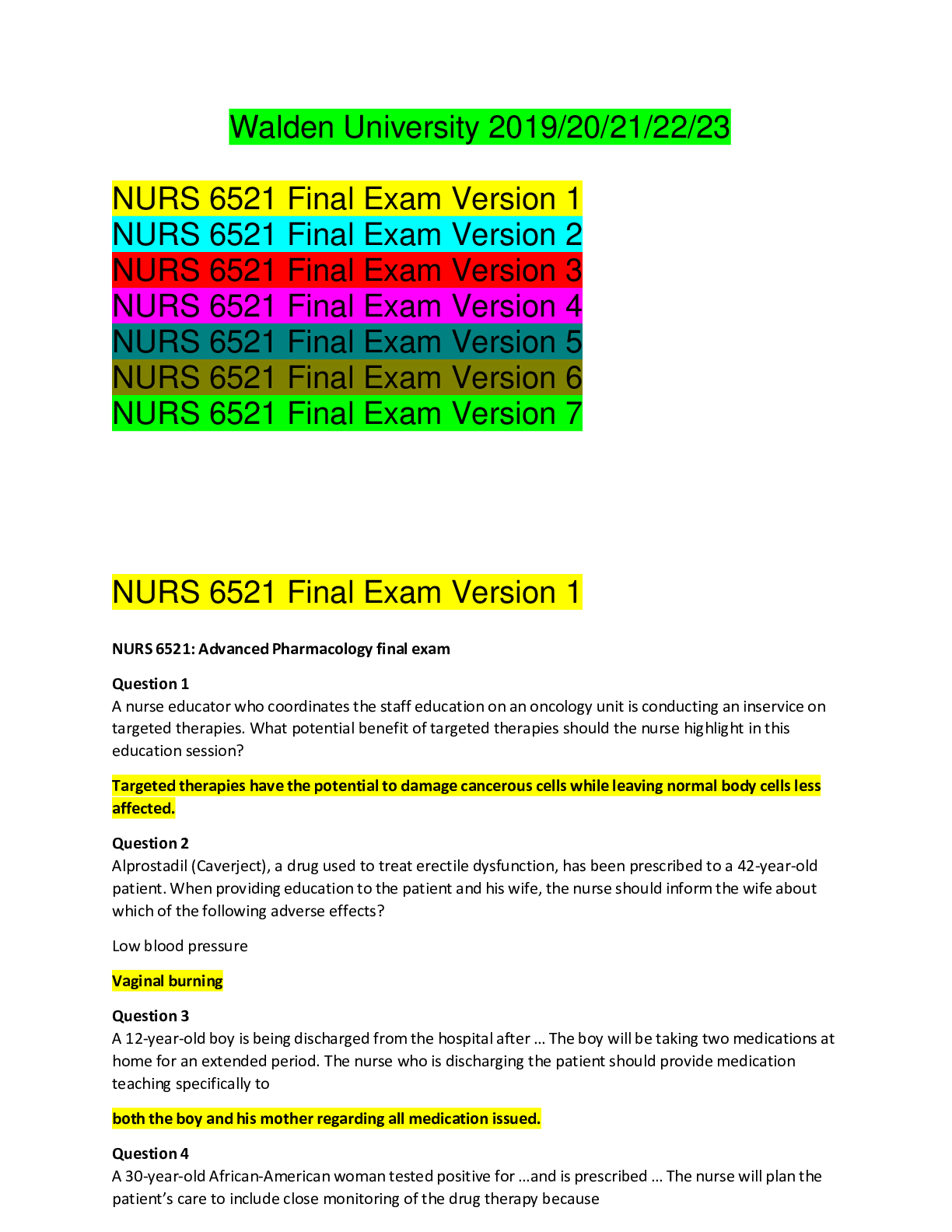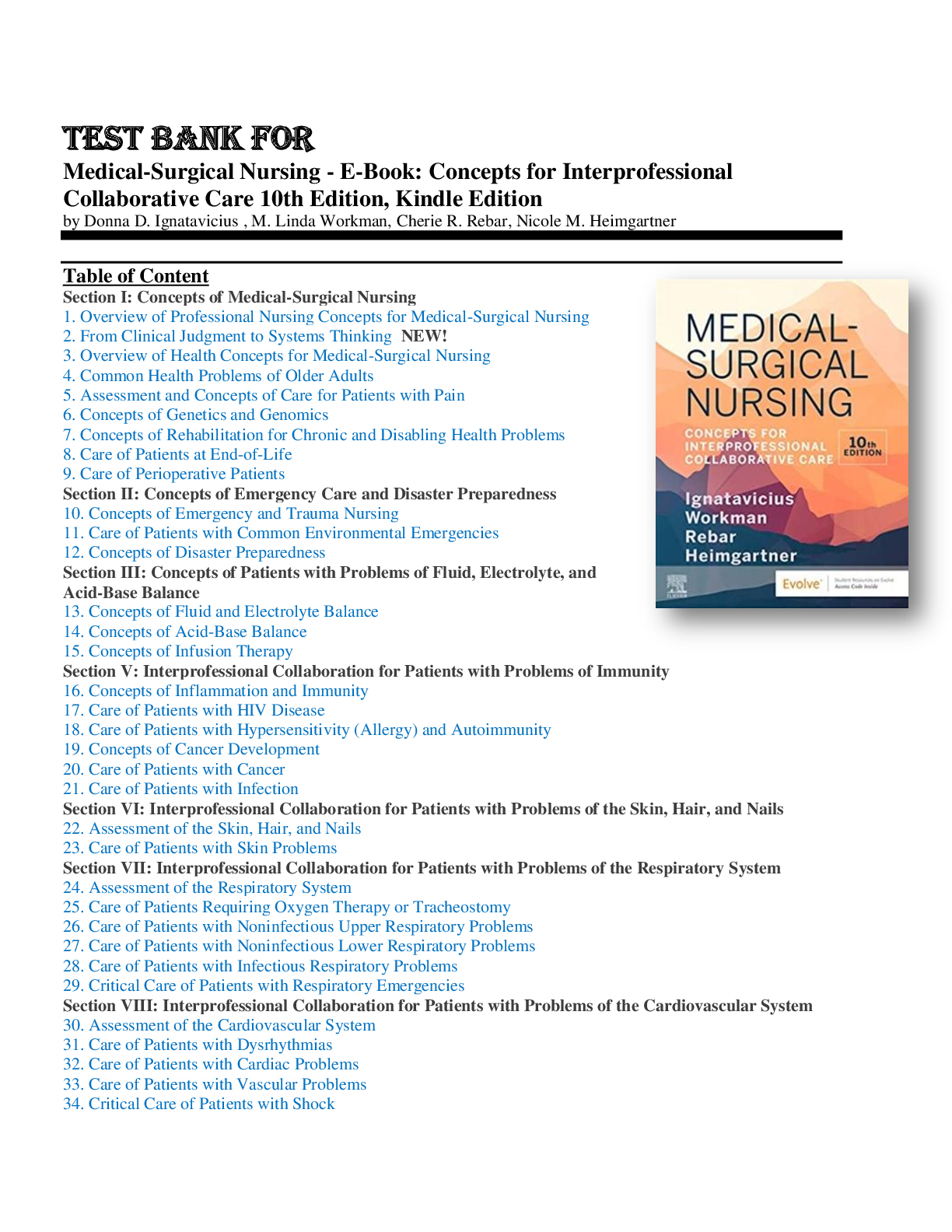Chapter 2 Measuring Income to Assess Performance
Document Content and Description Below
Introduction to Financial Accounting, 11e (Horngren) Chapter 2 Measuring Income to Assess Performance Learning Objective 2.1 Questions 1) The operating cycle begins with A) the acq... uisition of goods. B) the receipt of cash from customers. C) the payment for goods. D) the initial investment by owners. E) the sales to customers. Answer: Diff: 1 Objective: L.O. 2-1 2) Net income is A) the difference between revenues and dividends B) the difference between revenues and retained earnings. C) the difference between cash and dividends. D) the difference between revenues and total assets. E) the difference between revenues and expenses. Answer: Diff: 1 Objective: L.O. 2-1 3) Revenues are A) increases in liabilities resulting from delivering goods or services to customers. B) decreases in net assets resulting from delivering goods or services to customers. C) increases in net assets resulting from delivering goods or services to customers. D) decreases in retained earnings resulting from delivering goods or services to customers. E) another term for assets. Answer: Diff: 2 Objective: L.O. 2-1 4) For which company would it seem sensible to use a fiscal year ending on June 30? A) A landscaping company B) A retail store that sells lawn mowers and lawn equipment C) A swimming pool retailer D) A snowboard retailer E) A hardware store Answer: Diff: 2 Objective: L.O. 2-1 5) Kronic Enterprises sold inventory costing $500 for $900 on account. If Kronic Enterprises operates under the accrual basis, what net effect will this transaction have on the owners' equity side of the balance sheet? A) None, since the customer to whom the inventory was sold has not yet paid B) None, since sales and/or cost of goods sold are income statement accounts C) Decrease owners' equity by $1,400 D) Increase owners' equity by $400 E) Increase owners' equity by $1,400 Answer: Diff: 3 Objective: L.O. 2-1 6) An accountant records a transaction when cash is paid or received under which basis of accounting? A) Cash B) Accrual C) Deferral D) Prepaid E) Cost recovery Answer: Diff: 1 Objective: L.O. 2-1 7) Which of the following circumstances would result in a decrease in income under the accrual basis but would not result in a decrease in income under the cash basis? A) Purchase of inventory on account B) Payment of 2 months' rent in advance C) The expiration of prepaid rent D) The return of defective inventory purchased on account, where full credit was given E) The payment of the current period's utility bill Answer: Diff: 3 Objective: L.O. 2-1 8) Hilac Plumbing records revenue as cash is received. Which method of income measurement is Hilac Plumbing using? A) The accrual basis B) The cash basis C) The recognition basis D) The revenue basis E) The realization basis Answer: Diff: 2 Objective: L.O. 2-1 9) Which of the following circumstances would result in an increase in income under the cash basis and an increase in income under the accrual basis? A) The return of defective inventory purchased on account, where full credit was given B) Cash collection from a credit customer C) The cash sale of inventory at a sales price in excess of cost D) The expiration of prepaid rent E) The sale of inventory on account, at a sales price in excess of cost Answer: Diff: 3 Objective: L.O. 2-1 10) Which of the following circumstances would result in a decrease in income under both the accrual and cash basis? A) The payment of last period's rent B) The payment of this period's rent C) The payment of next period's rent D) The cash purchase of land E) The purchase of equipment on account Answer: Diff: 2 Objective: L.O. 2-1 11) An operating loss occurs when A) revenues exceed expenses. B) expenses exceed revenues. C) assets exceed liabilities. D) liabilities exceed assets. E) liabilities exceed owners equity. Answer: Diff: 1 Objective: L.O. 2-1 12) Expenses are A) increases in net assets as a result of consuming resources in the process of providing services to a customer. B) decreases in net assets as a result of consuming resources in the process of providing services to a customer. C) increases in liabilities resulting from purchasing assets. D) increases in retained earnings resulting from operations. E) increases in equity resulting from operations. Answer: Diff: 2 Objective: L.O. 2-1 13) The operating cycle is the time it takes for a company to buy goods. Answer: Diff: 1 Objective: L.O. 2-1 14) Because of the difficulty of measuring income, there is no reason to compare income levels between different companies. Answer: Diff: 1 Objective: L.O. 2-1 15) The additional owners' equity generated by net income or net profits is used to increase retained earnings. Answer: Diff: 1 Objective: L.O. 2-1 16) Because net income is the excess of revenues over liabilities, retained earnings increases by the amount of net income reported during the period less any dividends. Answer: Diff: 1 Objective: L.O. 2-1 17) According to accounting rules, fiscal years are required to be established over calendar years. Answer: Diff: 1 Objective: L.O. 2-1 18) An interim period is a time span that is less than a year and is established for accounting purposes. Answer: Diff: 1 Objective: L.O. 2-1 19) For revenue to be earned under the cash basis of accounting, the cash from the customer must be received. Answer: Diff: 1 Objective: L.O. 2-1 20) Cash for services performed in 20X8 is received in 20X9. Using the accrual basis of accounting, the revenue would appear on the 20X9 income statement. Answer: Diff: 2 Objective: L.O. 2-1 21) Revenue is recorded when accounts receivable are collected under the cash basis of accounting. Answer: Diff: 1 Objective: L.O. 2-1 22) Under the cash method, revenue is recorded when cash is collected. Answer: Diff: 1 Objective: L.O. 2-1 23) The accrual basis of accounting provides a better measure of economic performance than the cash basis. Answer: Diff: 1 Objective: L.O. 2-1 24) Analyze the following transactions in the accounting equation using the following worksheet. 1. Sales of inventory for $20,000 on account; merchandise cost is $13,000. 2. Rent payment made in advance for $1,500. 3. Acquire additional inventory for $8,000; paid $2,000 cash with remainder on credit. 4. Received payment of $4,000 from customer who purchased goods on credit last month. 5. Returned defective inventory in the amount of $500. The inventory was purchased on account. Accounts Prepaid Accounts Retained Cash Receivable Inventory Rent Payable Earnings 1 1 2 3 4 5 Answer: Accounts Prepaid Accounts Retained Cash Receivable Inventory Rent Payable Earnings 1 +20,000 +20,000 1 -13,000 -13,000 2 -1,500 +1,500 3 -2,000 +8,000 +6,000 4 +4,000 -4,000 5 -500 -500 Diff: 3 Objective: L.O. 2-1 25) Why doesn't the cash basis of accounting require adjusting accounts with accruals? Answer: The cash basis of accounting only records revenues and expenses when cash changes hands, while the accrual basis of accounting recognizes revenues when they are earned and expenses when they are incurred. Adjustments are necessary under the accrual basis of accounting since revenue can be earned even if cash is not received and expenses can be incurred even if cash is not paid. Diff: 2 Objective: L.O. 2-1 26) Describe the advantages of the accrual basis of accounting and the cash basis of accounting. Answer: The cash basis of accounting has the advantage of producing financial statements when cash is received and paid, giving users a clearer picture of the company's cash position. Proponents suggest that this is important since companies can appear to be doing well based on net income, yet go bankrupt for a lack of cash. The accrual basis of accounting has the advantage of producing a more complete summary of the entity's value-producing activities since it recognizes revenues when they are earned and expenses when they are incurred. Diff: 2 Objective: L.O. 2-1 Learning Objective 2.2 Questions 1) According to U.S. GAAP, revenue is recognized when it is A) realized or realizable only. B) earned only. C) received in a timely fashion. D) earned and realized or realizable. E) received in cash. Answer: Diff: 2 Objective: L.O. 2-2 2) Which of the following is an example of revenue that may be realized but not yet earned? A) A customer paying in advance for services to be performed in the future. B) A credit sale made to a customer who has a strong credit history. The goods have been delivered. C) A credit sale made to a customer with a weak credit history such that the collection of the outstanding receivable is questionable. The goods have been delivered. D) The cash sale of a fixed asset, as opposed to the sale of inventory. The fixed asset has been delivered. E) It is impossible to have revenue that is realized but not earned. Answer: Diff: 3 Objective: L.O. 2-2 3) Performing a service and receiving a promise to pay from the customer would A) increase revenue. B) decrease assets. C) increase liabilities. D) decrease expenses. E) decrease revenue. Answer: Diff: 1 Objective: L.O. 2-2 4) Ace Office Equipment is an office equipment company specializing in sales of printers, scanners, and copiers. When should Ace Office Equipment recognize revenue from its sales? A) When the customer calls to accept delivery of a new copier B) When the customer signs a contract to buy a copier C) When the copier is delivered to the customer D) When the payment is received from the customer E) When the financial statements are prepared that includes this sale Answer: Diff: 2 Objective: L.O. 2-2 5) Armingham Cable Company sells cable services and related accessories. Which of these situations demonstrate proper revenue recognition for Armingham Cable Company? A) Insurance is paid one month in advance of the due date because the Armingham Cable Company has extra cash. B) Cable services are sold to customers, and customers are billed in advance of receiving services. Revenue is recorded before rendering services. C) Cable boxes are purchased for sale to customers, but the accountant has not yet paid the bill. D) An interest bearing certificate of deposit is purchased. Interest will be received at the end of 60 days. Interest revenue will be recorded at the end of 60 days. E) Employees are paid for hours worked last month. Answer: Diff: 2 Objective: L.O. 2-2 6) Revenue is recognized when a customer's promise to pay exists, even if the company is not relatively certain that they will receive payment. Answer: Diff: 1 Objective: L.O. 2-2 Learning Objective 2.3 Questions 1) Mac's Computer Skills Training, purchased equipment for $30,000 on January 1, 20X8, and believes the equipment has a useful life of 36 months. What will be the effect of the equipment's depreciation on the balance sheet equation? A) Decreases Equipment account and decreases Stockholders' Equity B) Decreases Equipment account and increases Stockholders' Equity C) Increases Equipment account and decreases Stockholders' Equity D) Increases Equipment account and increases Stockholders' Equity E) There is no effect on the balance sheet equation. Answer: Diff: 2 Objective: L.O. 2-3 2) The recording of expenses in the same time period as the related revenues are recognized is known as A) cost recovery. B) realization. C) matching. D) recognition. E) period costs. Answer: Diff: 2 Objective: L.O. 2-3 3) Which of the following costs are identified directly as expenses of the time period in which they are incurred? A) Product costs B) Period costs C) Both product and period costs D) Neither product nor period costs E) Period costs as long as the goods have not been sold Answer: Diff: 2 Objective: L.O. 2-3 4) Which of the following costs are linked to the revenues earned during a period? A) Product costs B) Period costs C) Both product and period costs D) Neither product nor period costs E) Product costs as long as the goods remain in inventory Answer: Diff: 2 Objective: L.O. 2-3 5) Rent is paid one year in advance. The payment is recorded as an asset, Prepaid Rent, and 1/12 of the amount each month is recorded as Rent Expense. This is an example of which of the following concepts? A) Recognition B) Neutrality C) Realization D) Matching E) Product costs Answer: Diff: 2 Objective: L.O. 2-3 6) Which of the following accounts may be thought of as stored costs that are carried forward to future periods rather than immediately recorded as an expense? A) Prepaid insurance B) Utilities expense C) Salaries expense D) Depreciation expense E) Cost of goods sold Answer: Diff: 1 Objective: L.O. 2-3 7) What is the effect on a company's balance sheet equation when depreciation expense is recognized? A) This transaction affects only the income statement, so no change on the balance sheet will occur. B) Total assets and total stockholders' equity will decrease by the same amount. C) There will be no change in the total assets, liabilities, and stockholders' equity account. D) Total liabilities will increase and total stockholders' equity will decrease by the same amount. E) Without knowing the exact dollar amount of depreciation, the effect on the balance sheet cannot be determined. Answer: Diff: 3 Objective: L.O. 2-3 8) When a portion of prepaid rent expires, what will be the effect on the balance sheet equation? A) This transaction affects only the income statement, so there will be no effect on the balance sheet. B) There will be no overall effect on total assets, because two different asset accounts will change by the exact dollar amount, with one increasing and the other decreasing. C) Total assets and total liabilities will go down by the exact same dollar amount. D) Total assets and total stockholders' equity will go down by the exact same dollar amount. E) Without knowing the dollar amount of the transaction, the effect on the balance sheet equation cannot be determined. Answer: Diff: 3 Objective: L.O. 2-3 9) Expenses that are naturally linked to revenues are product costs. Examples of product costs include ________ and ________. A) Advertising Expense; Utilities Expense B) Rent Expense; Depreciation Expense C) Interest Revenue; Interest Expense D) Cost of Goods Sold; Sales Commissions Expense E) Administrative Expense; Selling Expense Answer: Diff: 2 Objective: L.O. 2-3 10) Floral Deliveries, Inc. paid $6,000 for January, February, March and April's rent in advance on January 1, 20X9. The company recorded this transaction by increasing the balance in the Prepaid Rent account. The balance in the Prepaid Rent account as of March 1, 20X9, will be A) $-0-. B) $1,500. C) $2,000. D) $3,000. E) $6,000. Answer: Diff: 2 Objective: L.O. 2-3 11) Floral Deliveries, Inc. paid $6,000 for January, February, March and April's rent in advance on January 1, 20X9. The company recorded this transaction by increasing the balance in the Prepaid Rent account. The balance in the Rent Expense account for the period, January 1, 20X9 through March 31, 20X9, as of March 31, 20X9, will be A) $-0-. B) $4,500. C) $2,000. D) $3,000. E) $6,000. Answer: Diff: 2 Objective: L.O. 2-3 12) On March 1, 20X9, Schmor Incorporated paid 6 months' insurance in advance, covering the period of March 1 to August 31, 20X9. The total payment was $4,200. At the time of the payment, the entire amount was used to increase the balance in the Prepaid Insurance account. What will be the balance in the Prepaid Insurance account as of March 31, 20X9? A) $-0- B) $700 C) $2,800 D) $3,500 E) $4,200 Answer: Diff: 2 Objective: L.O. 2-3 13) Which situation violates the matching principle? A) Employees are paid for wages worked in a previous month. The wages expense was recorded in the previous month. B) Consulting fees incurred have been recorded as an expense even though a bill has not yet been received. C) Depreciation was recorded for equipment even though the equipment was purchased on a date other than January 1. D) A 1-year insurance policy was paid in full on January 1 and the total amount of the bill was recorded as an expense in January. E) Customers are billed for services even though the company knows a portion of the customers will never pay. Answer: Diff: 2 Objective: L.O. 2-3 14) On January 1, 2015, equipment is purchased for $100,000. The equipment will be used for ten years and has no salvage value. What is the depreciation expense for the year ending December 31, 2016? A) $1,000 B) $2,000 C) $10,000 D) $20,000 E) $100,000 Answer: Diff: 2 Objective: L.O. 2-3 15) Accrual accounting uses the matching principle. Answer: Diff: 1 Objective: L.O. 2-3 16) The matching concept is closely related to the cash basis of accounting. Answer: Diff: 1 Objective: L.O. 2-3 17) Expenses, such as utilities, whose benefit is consumed by the passage of time rather than by the level of sales, are known as period costs. Answer: Diff: 2 Objective: L.O. 2-3 18) Costs that are linked with revenues and are charged as expenses when the related revenue is recognized are known as product costs. Answer: Diff: 2 Objective: L.O. 2-3 19) The process of allocating the cost of long-lived or fixed assets to expense is referred to as depreciation. Answer: Diff: 1 Objective: L.O. 2-3 20) Assets such as prepaid rent may be thought of as costs that are stored to be carried forward to future periods and recorded as expenses in the future. Answer: Diff: 2 Objective: L.O. 2-3 21) Under the accrual basis of accounting, prepaid assets become expenses when they expire. Answer: Diff: 1 Objective: L.O. 2-3 22) Use the following balance sheet equation format to show the effect of the following transactions. Write the account names that will be used for each transaction. Account name Total assets Total liabilities Paid-in capital Retained Earnings 1. The owners invest $42,000 in the company. 2. The company purchases equipment costing $6,000, paying $2,000 with the remainder as a note payable. 3. The company acquires inventory costing $2,500, paying $1,500 with the remainder on account. 4. Depreciation on the equipment was $200. Answer: Item Account name Total assets Total liabilities Paid-in capital Retained Earnings 1. Cash +42,000 Paid-in capital +42,000 2. Equipment +6,000 Cash (2,000) Note payable +4,000 3. Inventory +2,500 Cash (1,500) Accounts Payable +1,000 4. Depreciation expense (200) Accumulated Depreciation- Equipment (200) Diff: 2 Objective: L.O. 2-2 & 2-3 23) Describe how the matching concept is necessary to produce an income statement. Answer: The matching concept is necessary to relate product and period costs to the revenues that are generated in a given time period. Expenses are matched with revenues whenever it is reasonable and practicable to do so. Thus, the recognition of expense on the income statement is tied to the recognition of revenues. Diff: 2 Objective: L.O. 2-1 & 2-3 Learning Objective 2.4 Questions 1) Net income is defined as A) revenues minus expenses. B) expenses minus revenues. C) assets minus revenues. D) assets plus revenues. E) owners' equity assets minus expenses. Answer: Diff: 1 Objective: L.O. 2-4 2) Under accrual basis accounting, the recognition of salaries earned and the immediate payment of salaries to employees would A) increase assets. B) increase owners' equity. C) increase net income. D) decrease net income. E) increase revenue. Answer: Diff: 1 Objective: L.O. 2-4 3) The following data pertains to Greenwold Manufacturing. Total assets at January 1, 20X9, were $290,000; at December 31, 20X9, total assets were $334,000. During 20X9, sales were $995,000; cash dividends declared were $10,000; and operating expenses (exclusive of cost of goods sold) were $545,000. Total liabilities at December 31, 20X9, were $128,000; at January 1, 20X9, total liabilities were $105,000. There was no additional paid-in capital during 20X9. What was the amount of stockholders' equity as of January 1, 20X9? A) $450,000 B) $440,000 C) $185,000 D) $635,000 E) $175,000 Answer: Diff: 1 Objective: L.O. 2-4 4) The following data pertains to Greenwold Manufacturing. Total assets at January 1, 20X9, were $290,000; at December 31, 20X9, total assets were $334,000. During 20X9, sales were $995,000; cash dividends declared were $10,000; and operating expenses (exclusive of cost of goods sold) were $545,000. Total liabilities at December 31, 20X9, were $128,000; at January 1, 20X9, total liabilities were $105,000. There was no additional paid-in capital during 20X9. What was net income for 20X9? A) $26,000 B) $31,000 C) $201,000 D) $440,000 E) $450,000 Answer: Diff: 3 Objective: L.O. 2-4 5) The following data pertains to Greenwold Manufacturing. Total assets at January 1, 20X9, were $290,000; at December 31, 20X9, total assets were $334,000. During 20X9, sales were $995,000; cash dividends declared were $10,000; and operating expenses (exclusive of cost of goods sold) were $545,000. Total liabilities at December 31, 20X9, were $128,000; at January 1, 20X9, total liabilities were $105,000. There was no additional paid-in capital during 20X9. What was cost of goods sold for 20X9? A) $450,000 B) $435,000 C) $429,000 D) $419,000 E) $440,000 Answer: Diff: 3 Objective: L.O. 2-4 6) In an analysis of transactions using the balance sheet equation, revenues and expenses are adjustments to the ________ account. A) Accounts Receivable B) Accounts Payable C) Cash D) Capital Stock E) Retained Earnings Answer: Diff: 1 Objective: L.O. 2-4 7) Which statement is the major link between two balance sheets? A) Statement of Retained Earnings B) Statement of Stockholders Equity C) Statement of Cash Flows D) Statement of Balancing Equity E) Income Statement Answer: Diff: 1 Objective: L.O. 2-4 8) An account that may cause ethical conflict because of its need for judgment is A) utilities expense. B) accounts payable. C) accounts receivable. D) notes payable. E) depreciation expense. Answer: Diff: 1 Objective: L.O. 2-4 9) If sales amount to $150,000, rent expense is $2,000, utilities expense is $3,000, and net income is $55,000, how much is Cost of Goods Sold? A) $95,000 B) $145,000 C) $90,000 D) $50,000 E) $148,000 Answer: Diff: 2 Objective: L.O. 2-4 10) An income statement is a report of all revenues and expenses pertaining to a specific date. Answer: Diff: 1 Objective: L.O. 2-4 11) Net income appears on the income statement and balance sheet. Answer: Diff: 1 Objective: L.O. 2-4 12) The balance sheet provides a snapshot of an entity's financial position at an instant of time, while the income statement provides a moving picture of events over a span of time. Answer: Diff: 2 Objective: L.O. 2-4 13) The ending balance in retained earnings appears on the income statement. Answer: Diff: 1 Objective: L.O. 2-4 14) The Dyer Corporation began business operations on April 1, 20X9. The following transactions occurred during April 20X9: 1. The owner invested $32,000 in the company. 2. Inventory costing $13,000 was purchased. $900 in cash was paid; the remainder was put on account. 3. Equipment costing $23,000 was purchased, of which one-half was paid in cash. The remainder was paid with a note payable. Ignore interest expense. Depreciation for the month relating to the equipment was $1,500. 4. The rent for April, May, and June 20X9 was paid. The rent payment was $1,200. 5. Cash sales during the month totaled $8,900. The cost of the inventory sold was $5,100. 6. Credit sales during the month totaled $11,000. The cost of the inventory sold was $7,500. 7. The wages earned by the employees for the month were $4,000, although only $3,500 had been paid as of the end of the month. Given the previous transactions, determine the net income or loss using the accrual basis for the Dyer Corporation for the month of April, 20X9. Answer: Objective: L.O. 2-4 15) Dynamic Enterprises had the following information during November 20X9: Inventory purchases on account $ 6,800. Inventory purchases for cash $2,800. Sales on account $15,000. Cash sales $3,500. 1. Cost of goods sold on cash and credit sales $9,200 2. Payment of 3 months' rent in advance (1 month's rent should be recognized in November) 2,100 3. Payment of inventory purchased on account 3,000 4. Collections from credit customers 9,900 5. Wages earned and paid during November 5,000 6. Wages earned but not paid during November 3,200 7. Credit purchases of supplies 1,200 8. Supplies used during November 200 Required: Prepare an income statement for Dynamic Enterprises for the month of November, 20X9, under the accrual basis. Answer: Objective: L.O. 2-4 16) Following is the balance sheet for Value Creation, Inc. as of January 31, 20X9: Value Creation, Inc. Balance Sheet January 31, 20X9 Assets: Liabilities: Cash $ 7,100 Accounts Payable $ 6,200 Accounts Receivable 4,000 Notes Payable 8,300 Merchandise Inventory 13,500 Total Liabilities 14,500 Prepaid Rent 3,300 Stockholders' Equity: Store Equipment 15,600 Paid-in Capital $17,600 Retained Earnings 11,400 &nb [Show More]
Last updated: 1 year ago
Preview 1 out of 14 pages
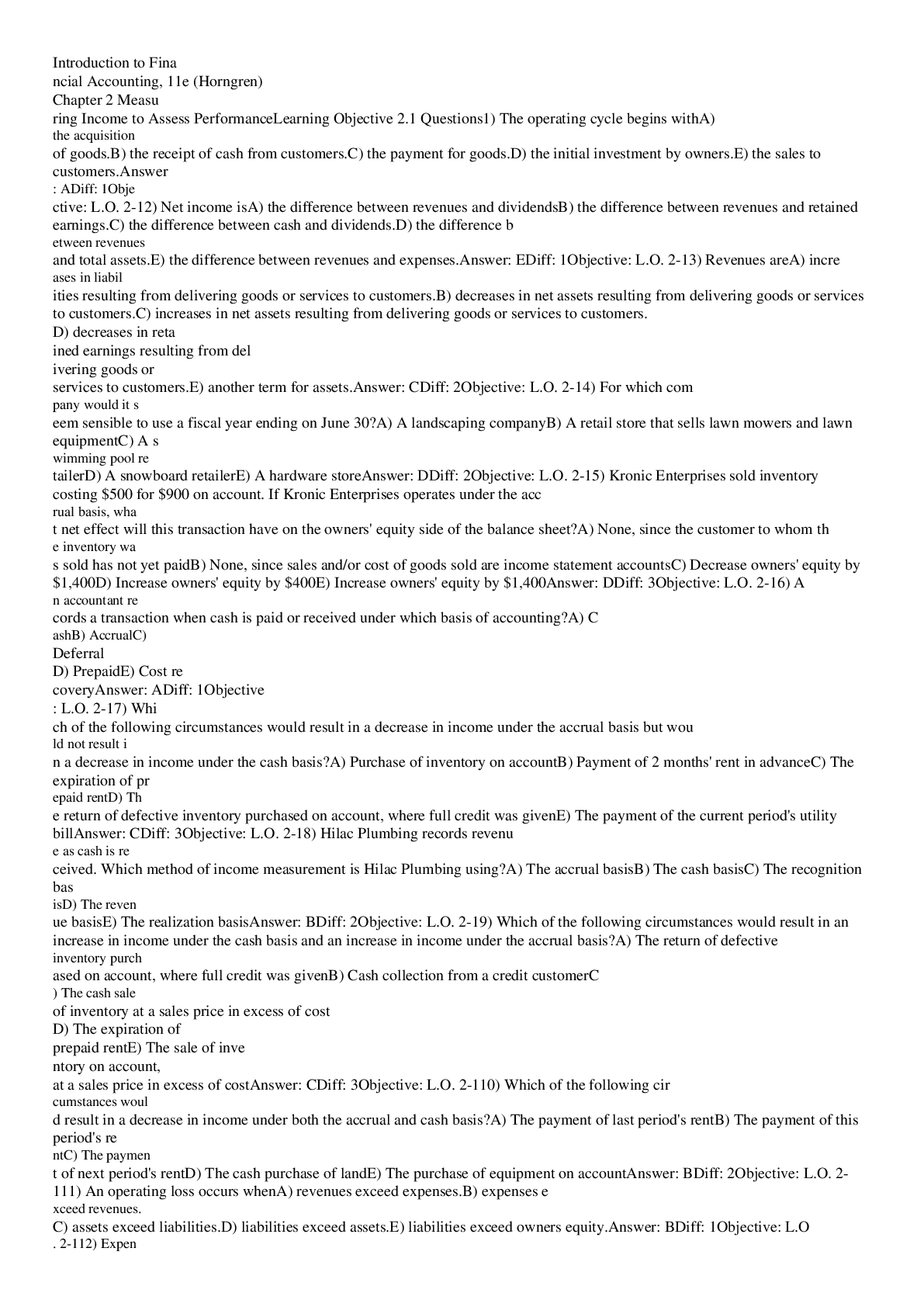
Buy this document to get the full access instantly
Instant Download Access after purchase
Add to cartInstant download
We Accept:

Reviews( 0 )
$7.00
Document information
Connected school, study & course
About the document
Uploaded On
Mar 09, 2021
Number of pages
14
Written in
Additional information
This document has been written for:
Uploaded
Mar 09, 2021
Downloads
0
Views
29

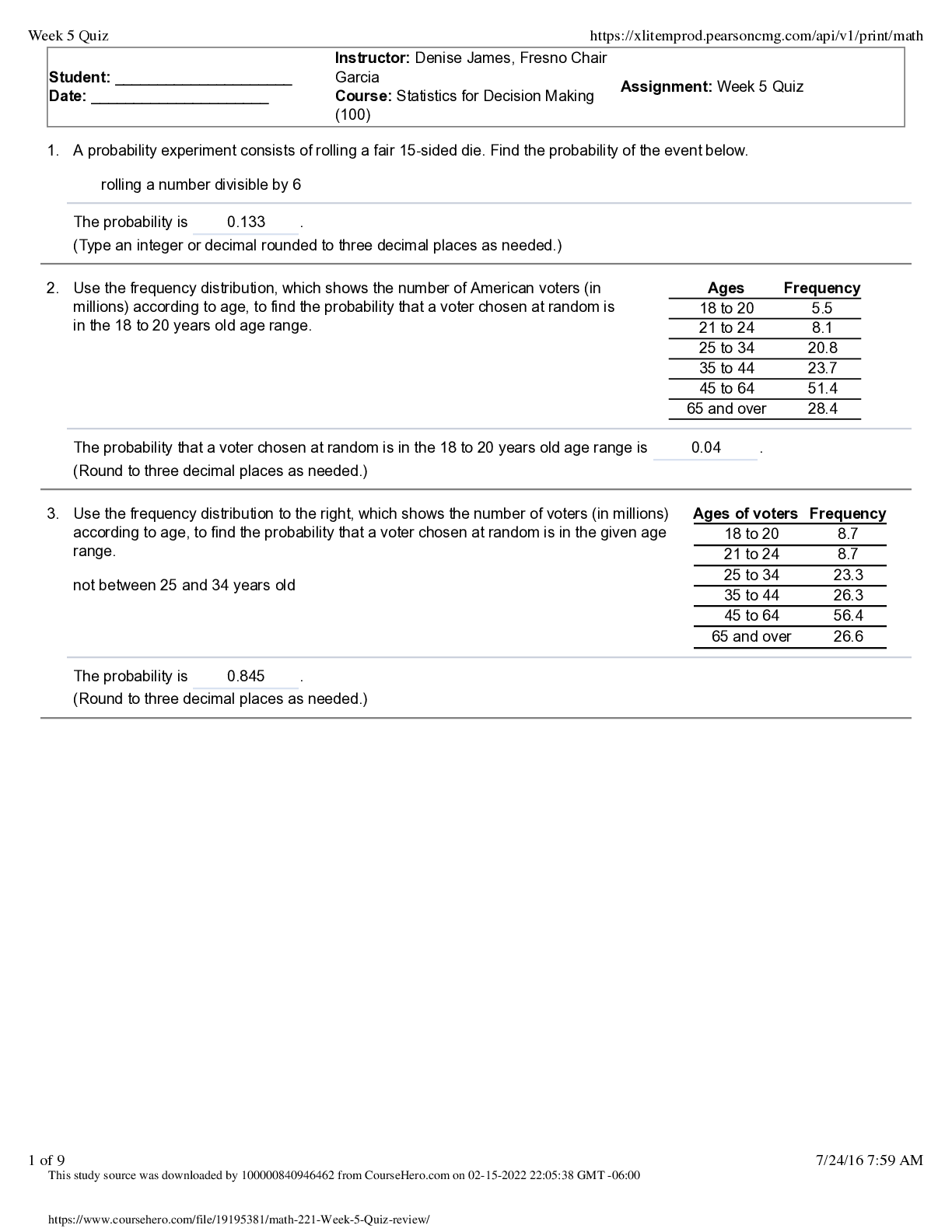


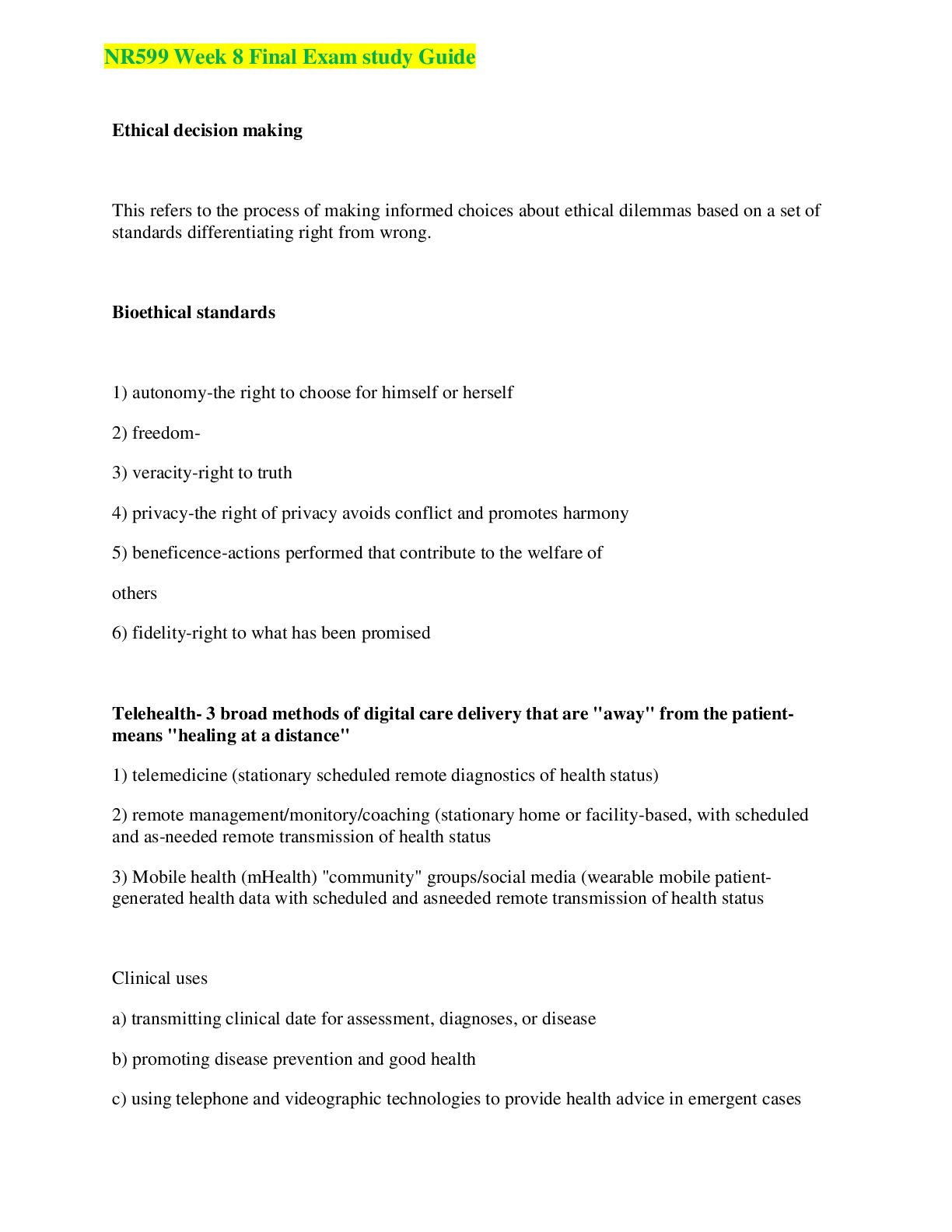

.png)

